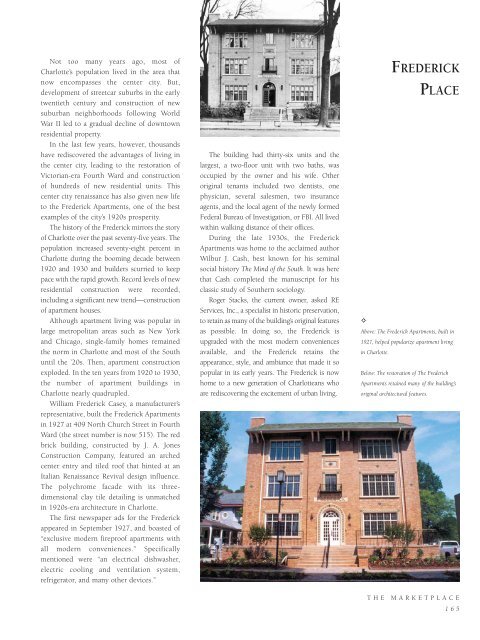Historic Charlotte
An illustrated history of the City of Charlotte and the Mecklenburg County area, paired with the histories of companies, families and organizations that make the region great.
An illustrated history of the City of Charlotte and the Mecklenburg County area, paired with the histories of companies, families and organizations that make the region great.
You also want an ePaper? Increase the reach of your titles
YUMPU automatically turns print PDFs into web optimized ePapers that Google loves.
Not too many years ago, most of<br />
<strong>Charlotte</strong>’s population lived in the area that<br />
now encompasses the center city. But,<br />
development of streetcar suburbs in the early<br />
twentieth century and construction of new<br />
suburban neighborhoods following World<br />
War II led to a gradual decline of downtown<br />
residential property.<br />
In the last few years, however, thousands<br />
have rediscovered the advantages of living in<br />
the center city, leading to the restoration of<br />
Victorian-era Fourth Ward and construction<br />
of hundreds of new residential units. This<br />
center city renaissance has also given new life<br />
to the Frederick Apartments, one of the best<br />
examples of the city’s 1920s prosperity.<br />
The history of the Frederick mirrors the story<br />
of <strong>Charlotte</strong> over the past seventy-five years. The<br />
population increased seventy-eight percent in<br />
<strong>Charlotte</strong> during the booming decade between<br />
1920 and 1930 and builders scurried to keep<br />
pace with the rapid growth. Record levels of new<br />
residential construction were recorded,<br />
including a significant new trend—construction<br />
of apartment houses.<br />
Although apartment living was popular in<br />
large metropolitan areas such as New York<br />
and Chicago, single-family homes remained<br />
the norm in <strong>Charlotte</strong> and most of the South<br />
until the ’20s. Then, apartment construction<br />
exploded. In the ten years from 1920 to 1930,<br />
the number of apartment buildings in<br />
<strong>Charlotte</strong> nearly quadrupled.<br />
William Frederick Casey, a manufacturer’s<br />
representative, built the Frederick Apartments<br />
in 1927 at 409 North Church Street in Fourth<br />
Ward (the street number is now 515). The red<br />
brick building, constructed by J. A. Jones<br />
Construction Company, featured an arched<br />
center entry and tiled roof that hinted at an<br />
Italian Renaissance Revival design influence.<br />
The polychrome facade with its threedimensional<br />
clay tile detailing is unmatched<br />
in 1920s-era architecture in <strong>Charlotte</strong>.<br />
The first newspaper ads for the Frederick<br />
appeared in September 1927, and boasted of<br />
“exclusive modern fireproof apartments with<br />
all modern conveniences.” Specifically<br />
mentioned were “an electrical dishwasher,<br />
electric cooling and ventilation system,<br />
refrigerator, and many other devices.”<br />
The building had thirty-six units and the<br />
largest, a two-floor unit with two baths, was<br />
occupied by the owner and his wife. Other<br />
original tenants included two dentists, one<br />
physician, several salesmen, two insurance<br />
agents, and the local agent of the newly formed<br />
Federal Bureau of Investigation, or FBI. All lived<br />
within walking distance of their offices.<br />
During the late 1930s, the Frederick<br />
Apartments was home to the acclaimed author<br />
Wilbur J. Cash, best known for his seminal<br />
social history The Mind of the South. It was here<br />
that Cash completed the manuscript for his<br />
classic study of Southern sociology.<br />
Roger Stacks, the current owner, asked RE<br />
Services, Inc., a specialist in historic preservation,<br />
to retain as many of the building’s original features<br />
as possible. In doing so, the Frederick is<br />
upgraded with the most modern conveniences<br />
available, and the Frederick retains the<br />
appearance, style, and ambiance that made it so<br />
popular in its early years. The Frederick is now<br />
home to a new generation of <strong>Charlotte</strong>ans who<br />
are rediscovering the excitement of urban living.<br />
FREDERICK<br />
PLACE<br />
✧<br />
Above: The Frederick Apartments, built in<br />
1927, helped popularize apartment living<br />
in <strong>Charlotte</strong>.<br />
Below: The restoration of The Frederick<br />
Apartments retained many of the building’s<br />
original architectural features.<br />
THE MARKETPLACE<br />
165
















